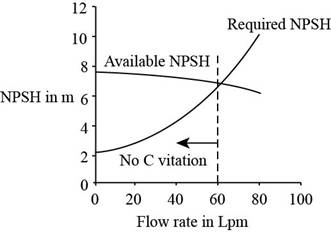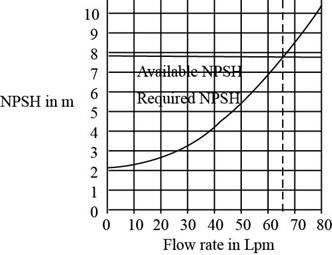
Concept explainers
Repeat Prob. 14-60, but with the pipe diameter increased by a factor of 2 (all else being equal). Does the volume flow rate at which cavitation occurs in the pump increase or decrease with the larger pipe? Discuss.
Whether the volume flow rate at which cavitations occurs in the pump increase or decrease of the larger pipe.
Answer to Problem 62P
The diameter of the pipe is doubled then the flow rate increase by
Explanation of Solution
Given information:
The pipe diameter is increased by the factor two.
Write the expression for the net positive suction head.
Here, the net positive suction head is
Write the expression for the total head loss.
Here, the friction factor is
Write the expression for the average speed.
Here, the diameter of the pipe is
Write the expression for the Reynolds number.
Here, the Reynolds number is
Write the expression for the friction factor.
Substitute
Write the expression for the required net positive suction head.
Here, the required net positive head is
Write the expression for the percentage increase.
Here, the percentage increase is
Calculation:
Refer the Table B-1, "The physical properties of saturated liquid" to obtain the value of the density is
Refer the Table B-1, "The physical properties of saturated liquid" to obtain the value of the kinematic viscosity is
Refer the Table B-1, "The physical properties of saturated liquid" to obtain the value of the vapor pressure is
Substitute
Substitute
Substitute
Substitute
Substitute
Substitute
The following table represents the net positive suction head, the required net positive suction head, and discharge.
| | |
Plot the graph by using tabulated values.

Figure-(1)
From Figure-(1), the cavitations occurs at the flow rate
Substitute
Substitute
Substitute
Substitute
Substitute
Substitute
The following table represents the net positive suction head, the required net positive suction head, and discharge.
| | |
Plot the graph by using tabulated values.

Figure-(2)
From Figure-(2), the cavitations occurs at the flow rate
Substitute
The diameter of the pipe is doubled then the flow rate increase by
Conclusion:
The diameter of the pipe is doubled then the flow rate increase by
Want to see more full solutions like this?
Chapter 14 Solutions
Connect Access for Fluid Mechanics
- is friction factor inversely proportional to the Reynold’s number in case of laminar flow in circular pipes?arrow_forwardDuring a retrofitting project of a fluid flow system to reduce the pumping power, it is proposed to install vanes into the miter elbows or to replace the sharp turns in 90° miter elbows by smooth curved bends. Which approach will result in a greater reduction in pumping power requirements?arrow_forwardWater in a partially filled large tank is to be supplied to the rooftop, which is 8 m above the water level inthe tank, through a 2.5 cm internal diameter pipe by maintaining a constant air pressure of 300 kPa (gauge) inthe tank. If the head loss in the piping system is 2 m of water, determine the discharge rate of the supply ofwater to the rooftop in L/s. Show complete solutionarrow_forward
- What are the primary differences between fans, blowers, and compressors? Discuss in terms of pressure rise and volume flow rate.arrow_forwardCombination of available data for transition and turbulent flow in smooth as well as rough pipes into the following implicit relation known as the_________________. Group of answer choices a. Bernoulli’s equation b. Continuity equation c. Colebrook’s equation d. Ideal gas equationarrow_forwardExplain how flow rate is measured with a turbine flowmeter, and discuss how they compare to other types of flowmeters with respect to cost, head loss, and accuracy.arrow_forward
- If the inner diameter of the penstock that deliver water form the dam to the hydroelectricpower plantis 90 cm and the water flows inside itat a rate of 10 L/s. (?=0.0131?????)a.Define the type of flowinside the penstockusing Reynolds numberequation.b.Explain the significance of the information we get from Reynolds number equation.arrow_forwardinclude a free body diagram Seawater is to be pumped into a large tank at a rate of 165 kg/min. The tank is opwn to atmostsphere and the water enters the tank from a 80 m height. The overall efficiency of the motor pump unit is 75 percent and the motor consumes electricity at a rate of 3.2 KW. If the irreversible headloss in the piping is 7 m, the velocity of the water (in m/s) at the tank inlet isA. 6.21B. 7.12C. 8.7D. 5.05arrow_forwardWhy are liquids usually transported in circular pipes?arrow_forward
- Water enters a hydraulic turbine through a 30 cm diameter tube at a rate of 0.6 m3/s and leaves through a 25 cm diameter tube. cm in diameter With a mercury manometer, the pressure drop across the turbine is measured to be 1.2 m For a combined efficiency (turbine-generator) of 83%, determine the net electrical power output. discard the effect of the kinetic energy correction factors.arrow_forwardNeed help with the following questionA reducing elbow in a horizontal pipe is used to deflect water by an angle of110° from the flow direction while accelerating it. Hot water at 80°C flowsat a rate of 33 kg/s in the pipe. The elbow discharges water into theatmosphere. The cross-sectional area of the elbow is 150 cm2at the inlet and25 cm2at the outlet. The elevation difference between the entrance and theexit of the pipe is 40cm. The total mass of the elbow and water in it is 50kg.Take the momentum-flux correction factor to be 1.03 at both inlet and outlet.Determine : -The inlet and outlet water velocities. -The gage pressure at the center of the inlet of the elbow. -The anchoring force required to hold the elbow in place.arrow_forwardA pipe of 0.25 m diameter carries water at the rate of 7.2 m3/s.The pressure head at the entry of the venturimeter, used to measure the flow rate in the pipe, is equivalent to 6 m of water. If the pressure head at the throat is zero, calculate the throat diameter of the venturi.Include fbd.arrow_forward
 Elements Of ElectromagneticsMechanical EngineeringISBN:9780190698614Author:Sadiku, Matthew N. O.Publisher:Oxford University Press
Elements Of ElectromagneticsMechanical EngineeringISBN:9780190698614Author:Sadiku, Matthew N. O.Publisher:Oxford University Press Mechanics of Materials (10th Edition)Mechanical EngineeringISBN:9780134319650Author:Russell C. HibbelerPublisher:PEARSON
Mechanics of Materials (10th Edition)Mechanical EngineeringISBN:9780134319650Author:Russell C. HibbelerPublisher:PEARSON Thermodynamics: An Engineering ApproachMechanical EngineeringISBN:9781259822674Author:Yunus A. Cengel Dr., Michael A. BolesPublisher:McGraw-Hill Education
Thermodynamics: An Engineering ApproachMechanical EngineeringISBN:9781259822674Author:Yunus A. Cengel Dr., Michael A. BolesPublisher:McGraw-Hill Education Control Systems EngineeringMechanical EngineeringISBN:9781118170519Author:Norman S. NisePublisher:WILEY
Control Systems EngineeringMechanical EngineeringISBN:9781118170519Author:Norman S. NisePublisher:WILEY Mechanics of Materials (MindTap Course List)Mechanical EngineeringISBN:9781337093347Author:Barry J. Goodno, James M. GerePublisher:Cengage Learning
Mechanics of Materials (MindTap Course List)Mechanical EngineeringISBN:9781337093347Author:Barry J. Goodno, James M. GerePublisher:Cengage Learning Engineering Mechanics: StaticsMechanical EngineeringISBN:9781118807330Author:James L. Meriam, L. G. Kraige, J. N. BoltonPublisher:WILEY
Engineering Mechanics: StaticsMechanical EngineeringISBN:9781118807330Author:James L. Meriam, L. G. Kraige, J. N. BoltonPublisher:WILEY





